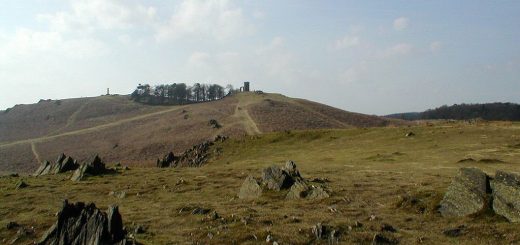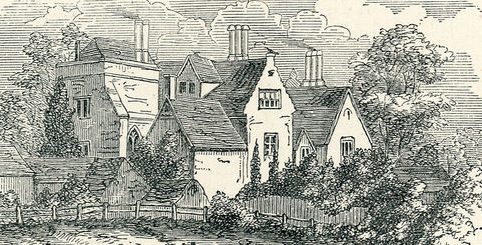Heath Old Hall
Heath Old Hall was demolished in 1961 and I beleive the site has been built upon. It was reputedly haunted by a Blue Lady, Dame Mary Bolles (Wytham), of Osberton, 1st Baronetess (1579 – 1662), daughter of William Witham of Ledstone Hall who is buried in the Parish Church of Ledsham.
 This is how the haunting was described in ‘The Haunted Homes and Family Traditions of Great Britain’ (1897) by John Ingram. ‘There are three Halls at Heath, near Wakefield, but the one known as the Old Hall, at present occupied by Edward Green, Esquire, is that which bears the reputation of being haunted. It is a truly magnificent and palatial pile of buildings, and has been well described to us as one of the finest specimens remaining in Yorkshire of the Elizabethan period of architecture. The Hall was built for John Kaye of Dalton. The windows were formerly emblazoned with the arms of many of the chief nobility of England, but these have disappeared, such painted glass as there is there now having been brought over by some nuns, with whom, it is said, was a Princess of Conde, who resided at the Hall during the Revolutionary troubles abroad.
This is how the haunting was described in ‘The Haunted Homes and Family Traditions of Great Britain’ (1897) by John Ingram. ‘There are three Halls at Heath, near Wakefield, but the one known as the Old Hall, at present occupied by Edward Green, Esquire, is that which bears the reputation of being haunted. It is a truly magnificent and palatial pile of buildings, and has been well described to us as one of the finest specimens remaining in Yorkshire of the Elizabethan period of architecture. The Hall was built for John Kaye of Dalton. The windows were formerly emblazoned with the arms of many of the chief nobility of England, but these have disappeared, such painted glass as there is there now having been brought over by some nuns, with whom, it is said, was a Princess of Conde, who resided at the Hall during the Revolutionary troubles abroad.
Mr. John Batty, to whom we are indebted for much of the following information, says, the Kayes were succeeded in possession of the Old Hall by William Witham, Esquire. This owner died in 1593, and it is not improbable that some peculiar circumstances which attended his disease and death first obtained for the place its curious reputation. His illness, and its fatal termination, were ascribed to demoniacal agency, and a poor woman of the neighbourhood, named Mary Pannal, who lay under the suspicion of being a witch, was arrested, and executed for the supposed crime at York.
William Witham’s son, Henry, dying without issue, Heath Old Hall became the property of his sister Mary, wife of Thomas Jobson of Cudworth, whose family had grown rich upon the plunder of abbey lands, another very potent reason for an uncanny fame being acquired by the race. Her first husband dying, Mary took for a second, Thomas Bolles, of Osberton, Nottinghamshire. Mary Bolles, whether for her loyalty or wealth is not stated, was created a baronetess of Scotland, with remainder to her heirs whatever, by James the First, in 1635, if not a solitary, still a very rare instance of such a title having been conferred. Lady Bolles lived in great state at the Old Hall, and, after much wealth and prosperity, died there in 1662, when eighty-three. Her interment did not take place until six weeks after her decease, she having assigned .120 a very much larger sum then than now for keeping open house for all comers during that time. Her will, only signed the day before her death, besides containing a number of charitable bequests, legacies to relatives and friends, and 200 for the erection of her tomb, further provides for the funeral festivities as follows: “I give all my fat beeves and fat sheep to be disposed of at the discretion of my executors, whom I charge to perform it nobly, and really to bestow this, my gift in good provision; two hogsheads of wine or more, as they shall see cause, and that several hogsheads of beer be taken care for (there being no convenience to brew). And, my bedding being plundered from me, I desire that the chambers may be well furnished with beds, borrowed for the time, for the entertaining of such as shall be thought fit lodgers.” Besides these arrangements, Lady Bolles left 700 to be expended in mourning, and 400 for funeral expenses, and charged her executors most earnestly to see her will exactly performed, adding that if any person interested in it obstructed them in any degree, he or she should forfeit all claim to any benefit from it.
The Old Hall fell to the share of Sir William Dalston, in right of his wife Anne, daughter of Lady Bolles by her second husband, but, after changing hands more than once, passed by purchase to John Smyth, Esquire, of Heath, from whom it descended to Captain Smyth, of the Grenadier Guards, its present possessor.
The Hall and its environs, says Mr. John Batty, are beautifully described in “Emilia Monterio,” a ballad by Mr. W. H. Leatham on a young Portuguese lady who lived with the nuns when they inhabited the Hall, some sixty years ago.
But the grand feature about this magnificent old Hall is that it is haunted, and by the apparition of Lady Bolles. Her ladyship is said to walk and disturb the neighbourhood; but her favourite resort is a fine banqueting-room, with a splendid carved stone chimney-piece, upon which are the Witham arms. Hunter, the Yorkshire antiquarian, deems that the lady’s restlessness in the grave may probably be connected with the romantic circumstances surrounding her father’s death; whilst others think it clue to the non-observance by her executors of certain clauses in her will. According to this latter account, the lady long “walked” in Heath Grove, till at length she was conjured down into a hole of the river, near the Hall, called to this day “Bolles Pit.” “The spell, however, was not so powerful but that she still rises and makes a fuss now and then.” A tradition, however, exists in Heath that a room in the edifice which she had had walled up for a certain period, because large sums of money had been gambled away in it, was opened before the stipulated time expired, hence the restlessness of Lady Bolles.
At any rate, even now-a-days she is reported to be seen sometimes gliding along the passages of the house she once inhabited in the flesh, whilst servants in a neighbouring residence have refused to go out after dark, as they have repeatedly seen at dusk a tall woman dressed in antiquated style in the coach-road of Heath Old Hall.
One correspondent, as evidence of the general feeling of the neighbourhood about this time-honoured apparition, informs us that when at Ledsham some time since, he was looking over the tomb in the north chancel, beneath which Lady Bolles lies buried, when two little lads whispered to him, rt Don’t go there, maister, there’s t’awd Lady! ” (Anglice, the Devil.)’
World War II troops stationed at Old Heath Hall in 1943 are said to have seen the ghost.




Recent Comments